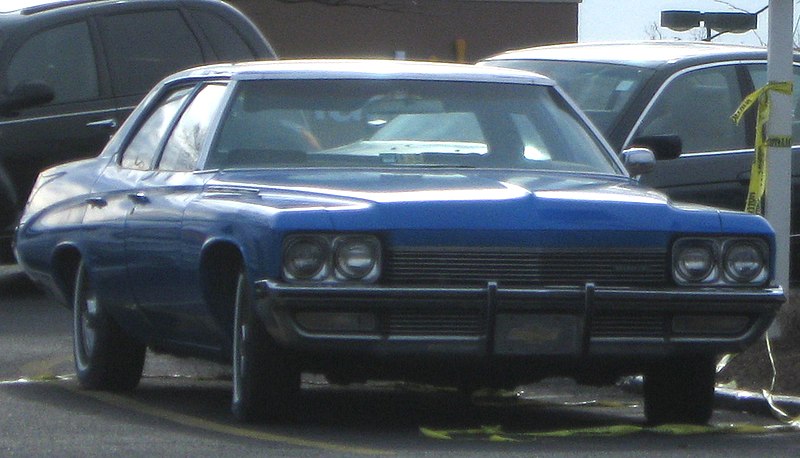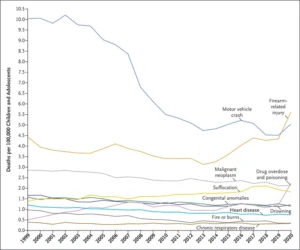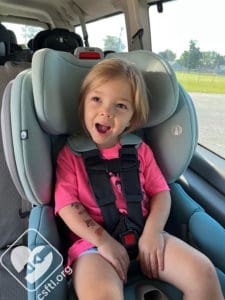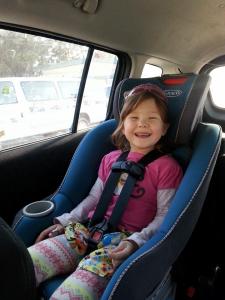“Once I was in preschool, the journey to high school began with me stepping into the again seat. No car seat belt or automotive seat was required again then – I simply plopped my 4 yr outdated self onto the seat and we had been off. Day by day, a part of our journey concerned stopping on the cease register entrance of the library. One terrible day, a passing automotive didn’t cease. It plowed into us, totaling our automotive and hurling unrestrained little me into the wheel nicely. I walked away. All of us walked away that day. The cease signal we stopped at each morning is now a site visitors mild.

Buick LeSabre picture courtesy of Wikimedia Commons
I do know now how very fortunate all of us had been that day. There have been no airbags within the car and we weren’t carrying the lap solely seat belts that had been accessible. Heck, I’m fairly positive that our 1973 Buick LeSabre didn’t actually have a crumple zone.
Regardless of my household being fortunate sufficient to stroll away from that crash again then, I can’t think about a state of affairs the place I might have finished the identical – ignored the seat belt and never used a automotive seat – for my very own youngsters. That’s as a result of occasions have modified, these gadgets not solely exist, automotive seats are getting simpler to put in and use correctly on a regular basis.
Finest practices for automotive seats and booster seats weren’t even a subject of dialog again then. And but, I can’t think about driving an unrestrained little one anyplace at this time!”
–CSFTL Admin Liz
The norms of the time that led our admin Liz’s household to ignore seat belts and never ever contemplate buying a automotive seat had been simply that – the norms of the time. Since that fateful day, automotive seats, automotive security, and even seat belt use have come a great distance. Increasingly more individuals can stroll away from crashes that will have been deadly, thanks to those helpful gadgets.
And but, we hear it on a regular basis in our Fb group: “Assist me persuade *insert anybody* that simply because they didn’t use automotive seats doesn’t imply it’s protected for them to drive my little one round with out one!”
Our focus is on preserving kids protected within the car – it isn’t on profitable arguments. However we acknowledge that many individuals who survived several types of automotive crashes or different doubtlessly life-threatening occasions really feel that simply because they survived, it someway signifies that no matter they did was protected. This angle is named survivorship bias and we’d like to handle it right here.
Anecdotal Fallacies in Survivorship Bias
We hear these arguments quite a bit:
- “I didn’t use a automotive seat and I survived!”
- “My youngsters put on coats within the automotive seat and they’re superb!”
- “Oh, my son ahead confronted at 1 yr outdated and nothing unhealthy occurred”
That’s nice! We’re very comfortable about these outcomes… however these statements beg fairly a number of questions, and the principle one is: what number of extreme collisions had been the speaker concerned in?
These are all examples of anecdotal fallacies. That’s the mindset that since an individual was not negatively impacted by a doubtlessly harmful state of affairs, (so far as they will inform), then nobody else will probably be negatively affected by the same state of affairs, both.
Useless males don’t inform tales. The youngsters and adults who didn’t survive don’t have any means of disputing the feedback made by those that did. It’s a reasonably one-sided argument that means, which is unlucky as a result of security measures like seat belts, airbags, and little one restraints save 1000’s of lives yearly.
A Temporary Historical past of Youngster Passenger Security
Vehicles weren’t created with security as a main characteristic. Vehicles had been invented to get individuals from level A to level B. That’s it. A way of transportation. Car security and the necessity for car security has advanced over time.
Seat Belt Historical past
The primary US Patent for a two-point seat belt (often known as a lap-only seat belt) was issued in 1885 and the outline was “designed to be utilized to the particular person, and supplied with hooks and different attachments for securing the particular person to a set object.” This can be a fairly apt definition of a lap-only seat belt – it secures an individual to a set object (like an car). Lap-only seat belts did maintain drivers and passengers contained in the car however additionally they led to severe belly accidents in high-speed motorcar collisions (particularly in race automotive drivers), which prompted Volvo Automotive Company’s chief security engineer Nils Bohlin to invent and patent the three-point seatbelt (lap/shoulder belt) that we see in fashionable automobiles in 1959.
Recognizing what a big security enchancment this lap/shoulder belt was over the unique lap-only belt, Volvo made the design accessible without spending a dime, and by 1968 the lap/shoulder belt was legally required on all newly manufactured US automobiles. “On the time of Bohlin’s demise in September 2002, Volvo estimated that the seat belt had saved a couple of million lives within the 4 a long time because it was launched” – that works out to over 29,000 lives saved per yr with this comparatively easy invention.
Automotive Seat Historical past
Earlier than the Sixties, automotive seats for security weren’t even being considered, since at the moment, little one seats had been solely created to assist kids see out of the window. It was frequent apply for youngsters to both be held by adults or older siblings or to take a seat by themselves within the car seat. The primary iterations of kid security seats had been launched in 1962 and 9 years later in 1971, Nationwide Freeway Site visitors Security Administration (NHTSA) launched the primary model of the federal motorcar normal FMVSS213 that defines necessities for little one restraints.
The 1971 model of FMVSS213 laws didn’t embody crash testing however did require two issues: the usage of a security belt and a harness to safe the kid. It wasn’t till 1979 that the primary state automotive seat legislation went into impact (in Tennessee) and by 1985, all states had adopted some model of automotive seat legal guidelines. Nonetheless, authorized doesn’t imply protected and innovation at all times precedes regulation.
Over the Years
The Nationwide Freeway Site visitors and Security Administration launched a Technical Report in December 1988 titled ‘Lives Saved by Youngster Restraints from 1982 by way of 1987.’ It was the primary technical report we had been capable of finding from them that addressed little one restraint utilization. The report included the next assertion:
“If all younger kids used little one restraints, extra lives could possibly be saved. With one hundred pc use, little one seats (with the combination of right and incorrect use throughout 1982 by way of 1987) might have saved an estimated: 369 lives in 1982, 380 lives in 1983, 355 lives in 1984, 378 lives in 1985, 405 lives in 1986, and 462 lives in 1987. “
Two thousand, 300 and forty 9 kids died in motorcar collisions throughout that point whom NHTSA believes might have lived had they used little one restraints. Youngster restraints within the Eighties weren’t far more than gadgets used to forestall kids from crawling across the car. They usually resembled a sort of seat one would use on the desk to make sure the kid was unable to flee till they completed their dinner – not one thing meant to maintain them protected within the occasion of a collision. But they did simply that, and (from the identical report) saved 838 kids’s lives between 1982 and 1987.
Right here is a few notable information from annual NHTSA stories:
1994:
- The 0-14 yr age group accounted for 7% (2,883) of the 40,676 site visitors fatalities within the US
- The place restrain use was identified, 50% of these kids had been unrestrained
- The 0-4 yr age group accounted for 681 of these fatalities and an estimated 58% (393 kids) had been unrestrained
2000:
- The 0-14 yr age group accounted for six% (2,343) of the 41,821 site visitors fatalities within the US
- The place restrain use was identified, 36% of these kids had been unrestrained
- The 0-4 yr age group accounted for 529 of these fatalities and an estimated 47% (251 kids) had been unrestrained
2010:
- The 0-14 yr age group accounted for 4% (1,210) of the 32,885 site visitors fatalities within the US
- The place restrain use was identified, 41% of these kids had been unrestrained
- The 0-4 yr age group accounted for 291 of these fatalities and an estimated 28% (77 kids) had been unrestrained
2020:
- The 0-14 yr age group accounted for 3% (1,093) of the 38,824 site visitors fatalities within the US
- The place restrain use was identified, 41% of these kids had been unrestrained
- The 0-4 yr age group accounted for 755 of these fatalities and the place restraint use was identified, 42% (286 kids) had been unrestrained (restraint utilization was identified for 680 fatalities)
Decreasing the proportion of kid fatalities by 4 % over 26 years might not seem to be a lot, however that signifies that in 2020, 1,553 kids’s lives had been saved by way of occupant safety methods that embody little one restraints.

the New England Journal of Drugs – Main Causes of Dying Amongst Kids and Adolescents in the USA, 1999 by way of 2020
Immediately
Even supposing the primary safety-focused automotive seat was remodeled 60 years in the past, we nonetheless don’t see 100% automotive seat utilization for youngsters. The older the kid is, the much less seemingly they’re to be in a automotive seat or booster seat in any respect.
In 2023, we all know much more now than we did within the 60s, 70s, and 80s… heck, we all know extra now than we did even 5-6 years in the past. We all know that kids shouldn’t be ahead going through earlier than they outgrow their convertible automotive seat rear going through, and that almost all 8-10-year-olds nonetheless want booster seats. So why don’t we see this in apply? Normally it’s attributable to individuals who survived conditions that was thought-about protected nonetheless believing that these practices are nonetheless thought-about protected at this time. And that assumption is improper.
In our Automotive Seats for the Littles Fb group(our technical discussion board the place we assist dad and mom and caregivers with their automotive seats) we see survivorship bias fairly usually.
Frequent conditions the place we see survivorship bias taking precedence over info:
- Ahead going through earlier than the convertible automotive seat is outgrown rear going through
- Utilizing a booster seat earlier than the kid is 5 years outdated and the kid continues to be inside the top and weight limits of harnessed automotive seats
- Discontinuing boosters earlier than becoming the grownup seat belt
- Utilizing aftermarket merchandise
- Permitting the kid to take a seat within the entrance car seat earlier than they’re 13 years outdated when another seating location within the again seat is offered
What we are able to Be taught
Expertise, innovation, laws, and legal guidelines will all change. The very best practices we all know at this time might nicely turn out to be outdated in time. Survivorship bias doesn’t simply apply to automotive seat security, however to many sides of parenting and life basically.
Methods to Counter Survivorship Bias Arguments
- Empathize. Automotive seats and normal car security requirements have advanced over time. The particular person you’re speaking to might not find out about this evolution.
- Educate. Take the time to elucidate the alternatives you’re making round little one passenger security.
Admin Liz walked away from that long-ago automotive crash we talked about at the beginning of the article. It might be really easy to imagine that as a result of she and her household had been fortunate on that ill-fated drive to preschool, they’d be fortunate on different drives as nicely. However the evolution in security requirements since that day meant that when Liz had youngsters of her personal, she knew higher and was capable of maintain these kiddos protected in a complete new means. Information is energy – studying about new enhancements on the subject of security can solely enhance issues.
References
https://theinventors.org/library/inventors/bl_seat_belts.htm
https://www.historical past.com/this-day-in-history/three-point-seatbelt-inventor-nils-bohlin-born
https://saferide4kids.com/weblog/the-general-history-of-car-seats/
https://crashstats.nhtsa.dot.gov/Api/Public/ViewPublication/813285
https://crashstats.nhtsa.dot.gov/Api/Public/ViewPublication/811641
NHTSA: Site visitors Security Details 2000 – Kids
https://crashstats.nhtsa.dot.gov/Api/Public/ViewPublication/807371
https://crashstats.nhtsa.dot.gov/Api/Public/ViewPublication/94F2




